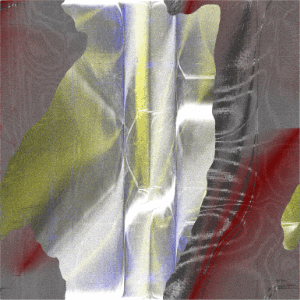Rapoon’s uchronia is an alternate, eerie and hermetic version of our world whose time period, cults and politics are similar to but not quite our own and whose topography, once traversed, is re-landscaped by an invisible hand. It is our planet of soil, water and air, but it is being run from deep within by a thrumming, well-oiled, man-made machine. Wordless, vexing incantations, perhaps ultimately more meaningful as evidence of human presence than vehicles of thoughts or devotions, recur throughout his discography.
The long, strange trip of Rapoon continues. Few of our contemporaries have created a surrogate reality so instantly recognizable yet existing at the very edge of familiarity. Rapoon’s uchronia is an alternate, eerie and hermetic version of our world whose time period, cults and politics are similar to but not quite our own and whose topography, once traversed, is re-landscaped by an invisible hand. It is our planet of soil, water and air, but it is being run from deep within by a thrumming, well-oiled, man-made machine. Wordless, vexing incantations, perhaps ultimately more meaningful as evidence of human presence than vehicles of thoughts or devotions, recur throughout his discography—you can hear them behind the curtain of radio static on “Hybrid Identities 2” on Time-Loop Anomalies and chiming like a soft bell on Stray‘s “Taken and Given.”
 Time-Loop Anomalies (Zoharum) [Release page] ~ A sketchbook, single tracks and “starts” re-routed through the remix so that the many directions now all head in one. Robin Storey says opening track “Sputnik Remix” is autobiographical, written in memory of seeing that “little pinprick of light travel through the heavens,” making a “deep impression of loneliness and separation upon me…bleak but beautiful.” With its brassy melody and woody, stand-up bass, it is reminiscent of Brian Eno’s playful experiment The Drop, of writing jazz for aliens who have never heard jazz before. “Pig Drum Ritual (Live Remix)” is like a boilerplate, Hollywood Arabian market scene scored for aliens, too. A quartet of pieces was created in collaboration with choreographer Johanna Devi for a deconstruction of Bizet’s Carmen staged in Germany, and featuring vocalist Eva Balzar, it is sensually suggestive and exotically rhythmic. His “Carmen 2 Hybrid Remix” sitar and saxophone is unlike any jazzified raga, and the Beatlesque reverse sitars on “Rapoon Solo Carmen” are unlike any Beatles. Whispers, chatter, secrets indecipherable throughout, rounded up definitively in a drone-carpeted finale, an interweaving of urban and pastoral so characteristic of his thematic dichotomies. As bodied-out sketches, most every track on Time-Loop Anomalies has the vibrancy of a full-colour oil painting and the whole album is the equivalent of a well-curated gallery show. It features an impressive breadth of subject matter and texture and cannot be fully absorbed and appreciated in one single visit. [Sample]
Time-Loop Anomalies (Zoharum) [Release page] ~ A sketchbook, single tracks and “starts” re-routed through the remix so that the many directions now all head in one. Robin Storey says opening track “Sputnik Remix” is autobiographical, written in memory of seeing that “little pinprick of light travel through the heavens,” making a “deep impression of loneliness and separation upon me…bleak but beautiful.” With its brassy melody and woody, stand-up bass, it is reminiscent of Brian Eno’s playful experiment The Drop, of writing jazz for aliens who have never heard jazz before. “Pig Drum Ritual (Live Remix)” is like a boilerplate, Hollywood Arabian market scene scored for aliens, too. A quartet of pieces was created in collaboration with choreographer Johanna Devi for a deconstruction of Bizet’s Carmen staged in Germany, and featuring vocalist Eva Balzar, it is sensually suggestive and exotically rhythmic. His “Carmen 2 Hybrid Remix” sitar and saxophone is unlike any jazzified raga, and the Beatlesque reverse sitars on “Rapoon Solo Carmen” are unlike any Beatles. Whispers, chatter, secrets indecipherable throughout, rounded up definitively in a drone-carpeted finale, an interweaving of urban and pastoral so characteristic of his thematic dichotomies. As bodied-out sketches, most every track on Time-Loop Anomalies has the vibrancy of a full-colour oil painting and the whole album is the equivalent of a well-curated gallery show. It features an impressive breadth of subject matter and texture and cannot be fully absorbed and appreciated in one single visit. [Sample]
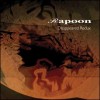 Disappeared Redux (Zoharum) [Release page] ~ Disappeared was first released in striclty limited formats two years ago and now reappears remixed and partly re-recorded. Here common leitmotifs appear in their most standard form. The narrative is intended to be “oblique and transitory,” not unlike our own relationship with others over time. Sometimes too oblique, perhaps, and recurring robotic spoken-word sequences alienate rather than draw the listener in deeper. The sound – sparser, drier—actually feels like some of the Rapoon has leached out of it. It is not without its many rewards, however—a slow-burning, solo piano meditation on “The Outside Shadow” that taxes its cheap loudspeaker, the blasted heath of “Breath of Ages,” a bone-gnawing “Snow Legend”—but ultimately too much chatter, too much wandering in the desert to be considered among his strongest work. Rapoon remains ambient music’s only true medicine man, but as Disppeared Redux proves, he can’t always make it rain. Until the next to last tack, “A Pale Blue Door” foreshadows what is one of his strongest albums yet. [Sample]
Disappeared Redux (Zoharum) [Release page] ~ Disappeared was first released in striclty limited formats two years ago and now reappears remixed and partly re-recorded. Here common leitmotifs appear in their most standard form. The narrative is intended to be “oblique and transitory,” not unlike our own relationship with others over time. Sometimes too oblique, perhaps, and recurring robotic spoken-word sequences alienate rather than draw the listener in deeper. The sound – sparser, drier—actually feels like some of the Rapoon has leached out of it. It is not without its many rewards, however—a slow-burning, solo piano meditation on “The Outside Shadow” that taxes its cheap loudspeaker, the blasted heath of “Breath of Ages,” a bone-gnawing “Snow Legend”—but ultimately too much chatter, too much wandering in the desert to be considered among his strongest work. Rapoon remains ambient music’s only true medicine man, but as Disppeared Redux proves, he can’t always make it rain. Until the next to last tack, “A Pale Blue Door” foreshadows what is one of his strongest albums yet. [Sample]
 Stray (Soleilmoon) ~ There is nothing either revisited, revamped or redundant about Stray. One of Rapoon’s most ethereal works to date, Stray opens with the slow eroding of a female church choir into something decidedly more earthy. “Ground Force” helixes a gauzy shroud around the axis of a quasi-industrial rhythm, a somber violin playing off the last vestiges of the choir. The whole album seems to be about a life force instilling the earth with its energy. Or instilling the world with ours. Has one of us gone astray? Those incantations, both human and avian, murmur throughout “As Days Move…,” hang long in humid air caught in dense foliage; you never heard birdsong so ominous. While “The Energy of Blue” turns with that relentless machine grind, rustier now, friction causing it to slowly wobble off centre, the squeaky wheel has apparently been given the grease by the time “Downstream and Delerious” begins rotating fluidly with a snake-charmer, hypnotizing gaze transfixing your attention. Finally, ”Lost God Particule…Echoing,” which takes up about a third of the album, is just about the saddest, most beautiful track Robin Storey has created as Rapoon. Coming as it does just as the scientists at CERN confirmed the existence of the so-called “God particle,” it makes for ideal listening while pondering your own response to the question posed by the man who named it—”If the universe is the answer, what is the question?” Stray brings together familiar Rapoon elements—tribal, industrial, ambient—but bathed in an alchemical bath that turns them into something new in the world and for the world. [Sample]
Stray (Soleilmoon) ~ There is nothing either revisited, revamped or redundant about Stray. One of Rapoon’s most ethereal works to date, Stray opens with the slow eroding of a female church choir into something decidedly more earthy. “Ground Force” helixes a gauzy shroud around the axis of a quasi-industrial rhythm, a somber violin playing off the last vestiges of the choir. The whole album seems to be about a life force instilling the earth with its energy. Or instilling the world with ours. Has one of us gone astray? Those incantations, both human and avian, murmur throughout “As Days Move…,” hang long in humid air caught in dense foliage; you never heard birdsong so ominous. While “The Energy of Blue” turns with that relentless machine grind, rustier now, friction causing it to slowly wobble off centre, the squeaky wheel has apparently been given the grease by the time “Downstream and Delerious” begins rotating fluidly with a snake-charmer, hypnotizing gaze transfixing your attention. Finally, ”Lost God Particule…Echoing,” which takes up about a third of the album, is just about the saddest, most beautiful track Robin Storey has created as Rapoon. Coming as it does just as the scientists at CERN confirmed the existence of the so-called “God particle,” it makes for ideal listening while pondering your own response to the question posed by the man who named it—”If the universe is the answer, what is the question?” Stray brings together familiar Rapoon elements—tribal, industrial, ambient—but bathed in an alchemical bath that turns them into something new in the world and for the world. [Sample]
For more information about Rapoon, visit rapoon.net






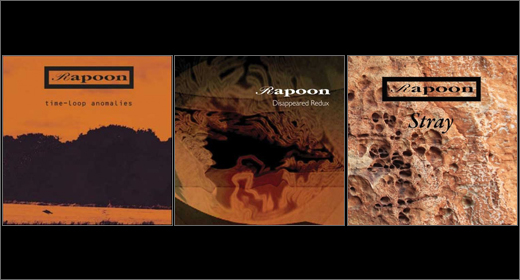



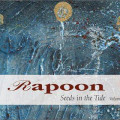
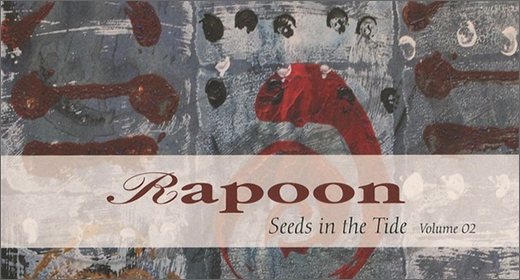
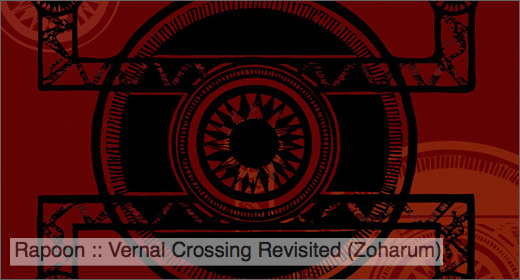
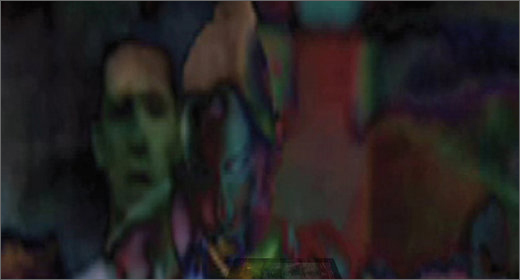



![Pole :: Tempus Remixes (Mute) — [concise]](https://igloomag.com/wp/wp-content/uploads/2025/04/pole-tempus-remixes_feat-75x75.jpg)






![Hasbeen :: Bunker Symphonies II (Clean Error) — [concise]](https://igloomag.com/wp/wp-content/uploads/2025/04/hasbeen-bunker-symphonies-ii_feat-75x75.jpg)
